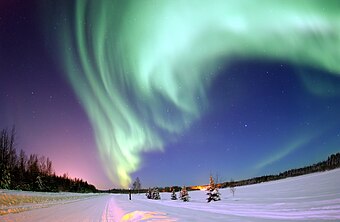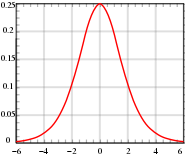Portal:Energy
| Main page | New articles & Tasks |
 The Energy Portal Welcome to Wikipedia's Energy portal, your gateway to energy. This portal is aimed at giving you access to all energy related topics in all of its forms.
|
Page contents: Selected article • Selected image • Selected biography • Did you know? • General images • Quotations • Related portals • Wikiprojects • Major topics • Categories • Help • Associated Wikimedia |
Introduction
In physics, energy (from Ancient Greek ἐνέργεια (enérgeia) 'activity') is the quantitative property that is transferred to a body or to a physical system, recognizable in the performance of work and in the form of heat and light. Energy is a conserved quantity—the law of conservation of energy states that energy can be converted in form, but not created or destroyed. The unit of measurement for energy in the International System of Units (SI) is the joule (J).
Common forms of energy include the kinetic energy of a moving object, the potential energy stored by an object (for instance due to its position in a field), the elastic energy stored in a solid object, chemical energy associated with chemical reactions, the radiant energy carried by electromagnetic radiation, and the internal energy contained within a thermodynamic system. All living organisms constantly take in and release energy.
Due to mass–energy equivalence, any object that has mass when stationary (called rest mass) also has an equivalent amount of energy whose form is called rest energy, and any additional energy (of any form) acquired by the object above that rest energy will increase the object's total mass just as it increases its total energy.
Human civilization requires energy to function, which it gets from energy resources such as fossil fuels, nuclear fuel, or renewable energy. The Earth's climate and ecosystems processes are driven by the energy the planet receives from the Sun (although a small amount is also contributed by geothermal energy). (Full article...)
Selected article
Renewable energy reached a major milestone in the first quarter of 2011, when it contributed 11.7 percent of total U.S. energy production (2.245 quadrillion BTUs of energy), surpassing energy production from nuclear power (2.125 quadrillion BTUs). 2011 was the first year since 1997 that renewables exceeded nuclear in US total energy production.
Hydroelectric power is currently the largest producer of renewable power in the U.S. It produced around 6.2% of the nation's total electricity in 2010 which was 60.2% of the total renewable power in the U.S. The United States is the fourth largest producer of hydroelectricity in the world after China, Canada and Brazil.
U.S. wind power installed capacity now exceeds 65,000 MW and supplies 4% of the nation's electricity. Texas is firmly established as the leader in wind power development, followed by Iowa and California. The largest solar thermal power station is the Ivanpah Solar Power Facility (392 MW), south west of Las Vegas, and the SEGS group of plants in the Mojave Desert with a total generating capacity of 354 MW. Large photovoltaic power plants in the USA include Solar Star (579 MW), near Rosamond, California, the Desert Sunlight Solar Farm, a 550 MW solar power plant in Riverside County, California, and the Topaz Solar Farm, a 550 MW photovoltaic power plant, in San Luis Obispo County, California. The Geysers in Northern California is the largest complex of geothermal energy production in the world.
In his 2012 State of the Union address, President Barack Obama restated his commitment to renewable energy and energy efficiency, and mentioned the long-standing Interior Department goal to permit 10,000 MW of renewable energy projects on public land in 2012.
Selected image

Photo credit: Senior Airman Joshua Strang, United States Air Force
An aurora, caused by the release of energy as charged particles collide with atoms in the Earth's upper atmosphere.
Did you know?
- The development of renewable energy in Iceland means that by 2050 the country should be the world's first zero-carbon economy?
- World's two largest oil shale-fired power plants (Narva Power Plants) generate more than 90% of power in Estonia?
- NW Natural in Portland, Oregon was the first gas company in the Pacific Northwest region of the United States when it started in 1859?
- The Assistant Secretary of Energy for Fossil Energy is responsible for America's Strategic Petroleum Reserve?
- Despite declines in production in recent years, Victoria still produces almost 20% of Australia's crude oil?
- 4.26 million tonnes of the Sun are converted to energy every second by nuclear fusion?
- The first gasworks in the United Kingdom was built by the Gas Light and Coke Company, incorporated by Royal Charter in 1812?
- The Baku–Tbilisi–Ceyhan pipeline was a central plot point in the James Bond film The World Is Not Enough?
Selected biography
Born in Texas, Hubbert studied geology, mathematics, and physics at the University of Chicago. He pursued his Ph.D. while working for the Amerada Petroleum Company, then worked for the Shell Oil Company from 1943 until 1964. On leaving Shell he became a senior research geophysicist for the United States Geological Survey until retiring in 1976. Hubbert was also a professor at Stanford University and at UC Berkeley.
Hubbert is most well-known for his studies on the capacities of oil fields and natural gas reserves. He predicted that, for any given geographical area, the rate of petroleum production over time would resemble a bell curve. At the 1956 meeting of the American Petroleum Institute, Hubbert predicted that United States petroleum production would peak in the late 1960s or early 1970s. He became famous when his prediction came true in 1970.
In 1974, Hubbert projected that global oil production would peak in 1995 "if current trends continue". Various subsequent predictions have been made by others as trends have fluctuated in the intervening years. Hubbert's theory, and its implications for the world economy, remain controversial.
General images
The time allocated for running scripts has expired.
The time allocated for running scripts has expired. The time allocated for running scripts has expired.
The time allocated for running scripts has expired. The time allocated for running scripts has expired.
The time allocated for running scripts has expired.
WikiProjects connected with energy:
Other WikiProjects that may be of interest:
The time allocated for running scripts has expired.
The time allocated for running scripts has expired.
National energy supply, use & conservation
National electricity sector
Politics, economics, environment
- Climate change
- Energy conservation
- Energy economics
- Energy crises
- Energy development
- Energy policy
- Peak oil
Energy sources
- Fuels
- Biofuels
- Fossil fuels
- Fusion power
- Nuclear technology
- Renewable energy
- Energy conversion
- Electric power
- Energy storage
Energy-related design
Scientific usage
The time allocated for running scripts has expired.

Puzzled by energy?
Can't answer your question?
Don't understand the answer?
- Ask at the reference desk
- Read the Wikipedia help pages
For further ideas, to leave a comment, or to learn how you can help improve and update this portal, see the talk page.
The time allocated for running scripts has expired.
The following Wikimedia Foundation sister projects provide more on this subject:
-
Commons
Free media repository -
Wikibooks
Free textbooks and manuals -
Wikidata
Free knowledge base -
Wikinews
Free-content news -
Wikiquote
Collection of quotations -
Wikisource
Free-content library -
Wikiversity
Free learning tools -
Wiktionary
Dictionary and thesaurus




















































